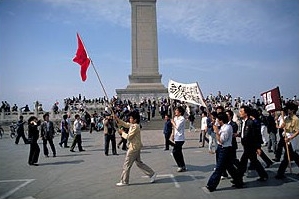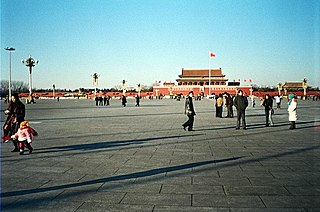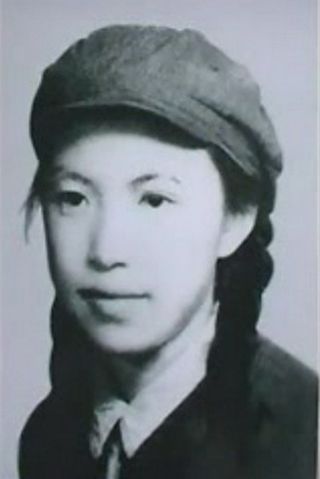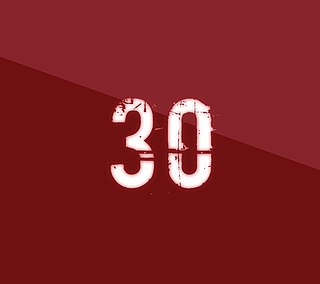
The Tiananmen Square protests, known in China as the June Fourth Incident, were student-led demonstrations held in Tiananmen Square, Beijing, China, lasting from 15 April to 4 June 1989. After weeks of unsuccessful attempts between the demonstrators and the Chinese government to find a peaceful resolution, the Chinese government declared martial law on the night of 3 June and deployed troops to occupy the square in what is referred to as the Tiananmen Square massacre. The events are sometimes called the '89 Democracy Movement, the Tiananmen Square Incident, or the Tiananmen uprising.

Chai Ling is a Chinese psychologist and businesswoman who was one of the student leaders in the 1989 Tiananmen Square protests. She was a representative of the hardline faction of the protest movement and according to a documentary, Gate of Heavenly Peace, she had indicated that the strategy of the leadership group she dominated was to provoke the Government to use violence against the unarmed students. Comments that she made to that effect in an interview later formed the basis of two lawsuits. She had also claimed to have witnessed soldiers killing student protesters inside Tiananmen Square.

The Goddess of Democracy, also known as the Goddess of Democracy and Freedom, the Spirit of Democracy, and the Goddess of Liberty, was a 10-metre-tall (33 ft) statue created during the 1989 Tiananmen Square protests. The statue was constructed over four days out of foam and papier-mâché over a metal armature and was unveiled and erected on Tiananmen Square on May 30, 1989. The constructors decided to make the statue as large as possible to try to dissuade the government from dismantling it: the government would either have to destroy the statue—an action which would potentially fuel further criticism of its policies—or leave it standing. Nevertheless, the statue was destroyed on June 4, 1989, by soldiers clearing the protesters from Tiananmen square. Since its destruction, numerous replicas and memorials have been erected around the world, including in Hong Kong, San Francisco, Washington, D.C., and Vancouver.
The Tiananmen Mothers is a group of Chinese democracy activists promoting a change in the government's position over the 1989 Tiananmen Square protests and massacre. It is led by Ding Zilin, a retired university professor whose teenage son was shot and killed by government troops during the protests. The group – comprising the parents, friends and relatives of victims of the massacre – formed in September 1989 when Ding, along with her husband Jiang Peikun, met another mother, Zhang Xianling, whose 19-year-old son was also killed on June 4, 1989. As well as campaigning, the group also disseminates information about the events to the public, including through the internet. Currently, the group consists of relatives of 125 individuals killed during the protests. For her efforts, Ding has been hailed as an "advocate for the dead".

The Tank Man is the nickname given to an unidentified individual, presumed to be a Chinese man, who stood in front of a column of Type 59 tanks leaving Tiananmen Square in Beijing on June 5, 1989, the day after the government of China had massacred hundreds of protesters. As the lead tank maneuvered to pass by the man, he repeatedly shifted his position in order to obstruct the tank's attempted path around him, and forced the tanks to halt to avoid running him over. The incident was filmed and shared to a worldwide audience. Internationally, it is considered one of the most iconic images of all time. Inside China, the image and the accompanying events are subject to censorship.
Jan Wong is a Canadian academic, journalist, and writer. Wong worked for The Globe and Mail, serving as Beijing correspondent from 1988 to 1994, when she returned to write from Canada. She is the daughter of Montreal businessman Bill Wong, founder of Bill Wong's buffet in 1963, and earlier of the House of Wong which was the city's first Chinese restaurant to open outside Chinatown.

Ding Zilin is a retired professor of philosophy and the leader of the political activist group Tiananmen Mothers. Ding is the mother of Jiang Jielian, one of the first student protestors killed during the 1989 Tiananmen Square protests and ensuing crackdown.
Chen Xitong was a member of the Politburo of the Chinese Communist Party and the Mayor of Beijing until he was removed from office on charges of corruption in 1995.

The Gate of Heavenly Peace is a 1995 documentary film, produced by Richard Gordon and Carma Hinton, about the Tiananmen Square protests of 1989.

Tiananmen Square or Tian'anmen Square is a city square in the city center of Beijing, China, named after the eponymous Tiananmen located to its north, which separates it from the Forbidden City. The square contains the Monument to the People's Heroes, the Great Hall of the People, the National Museum of China, and the Mausoleum of Mao Zedong. Mao Zedong proclaimed the founding of the People's Republic of China in the square on October 1, 1949; the anniversary of this event is still observed there. The size of Tiananmen Square is 765 x 282 meters. It has great cultural significance as it was the site of several important events in Chinese history.

Lin Zhao, born Peng Lingzhao (彭令昭), was a prominent Chinese dissident who was imprisoned and later executed by the People's Republic of China during the Cultural Revolution for her criticism of Mao Zedong's policies. She is widely considered to be a martyr and exemplar for Chinese and other Christians, like the Chinese church leader and teacher Watchman Nee.

During the 1989 Tiananmen Square protests and massacre in Beijing, the Chinese People's Liberation Army (PLA) played a decisive role in enforcing martial law, using force to suppress the demonstrations in the city. The killings in Beijing continue to taint the legacies of the party elders, led by Chinese leader Deng Xiaoping, and weigh on the generation of leaders whose careers advanced as their more moderate colleagues were purged or sidelined at the time. Within China, the role of the military in 1989 remains a subject of private discussion within the ranks of the party leadership and PLA.

Feng Congde is a Chinese dissident and Republic of China Restoration activist. He was a student leader from Peking University during the Tiananmen Square protests of 1989, which placed him onto the Chinese government's 21 Most Wanted list. He spent 10 months hiding in various locations in mainland China, until he was smuggled out to Hong Kong on a shipping vessel.
The 1989 Tiananmen Square protests and massacre were the first of their type shown in detail on Western television. The Chinese government's response was denounced across the world; a report by the U.S. State Department said: "Foreign governments have expressed near universal revulsion over the crackdown although a few exceptions have supported China's approaches. Negative reactions range from punitive measures by Western countries to private criticisms in the East." Specifically, it said: "China's credentials as a socialist reformer were being called into question not only by Western European communists but also by progressives in Eastern Europe and, to a lesser extent, the Soviet Union." Notably however, many Asian countries remained silent throughout the protests; the government of India responded to the massacre by ordering the state television to pare down the coverage to the barest minimum, so as not to jeopardize a thawing in relations with China, and to offer political empathy for the events. Criticism came from both Western and Eastern Europe, North America, Australia and some east Asian and Latin American countries. North Korea, Cuba, Czechoslovakia, and East Germany, among others, supported the Chinese government and denounced the protests. Overseas Chinese students demonstrated in many cities in Europe, America, the Middle East, and Asia against the Chinese government.
The 24th anniversary of Tiananmen Square protests of 1989 took place in China and internationally around 4 June 2013. The protests commemorated victims of the Chinese Communist Party crackdown on the Tiananmen Square protests of 1989. Activities included the state of alert within mainland China, and the traditional marches and candlelight vigils that took place in Hong Kong and Macau on 4 June 2013 which have taken place every year prior to that since 1990. The two former colonies are the only places on Chinese soil where the 1989 crushing of China's pro-democracy movement can be commemorated.

A Heart for Freedom: The Remarkable Journey of A Young Dissident, Her Daring Escape, And Her Quest to Free China's Daughters is an autobiography by Chai Ling (柴玲), one of the student leaders in the Tiananmen Square protests of 1989 in Beijing, China. The book was published in 2011 by Tyndale House, a Christian press based in Illinois.

Jiang Jielian was a second-year student at the High School Affiliated to Renmin University of China. He was killed by People’s Liberation Army (PLA) behind a flower bed in front of Building 29, on the north side of Fuwai Street, Muxidi, Beijing, at the age of 17 when PLA units advanced on Tiananmen Square to crack down on the student-led demonstrations. After the June 4 massacre, Jiang was the first casualty of high school age whose death was acknowledged in internal bulletins by the Chinese Communist Party (CCP) authorities. According to the authorities, Jiang was one of "more than two hundreds" of Beijing citizens who got shot or killed while trying to stop the PLA units from entering Beijing on the night of June 3, 1989. The real figure remained unknown but predicted as at least seven times higher. Jiang's death also triggered the Tiananmen Mothers movement, which was initiated and organized by Jiang's parents, Jiang Peikun and Ding Zilin, both of whom were professors at Renmin University of China. During an interview with a Canadian journalist on June 4, 1993, Ding said, "My government called him a rioter but he was not. He was a student who only had the idea of democracy".
Many women participated in the Tiananmen Square Protests of 1989 for democratic reform in China. Lee Feigon states "women [during the Tiananmen Square Protests] were relegated for the most part to traditional support roles." Chai Ling and Wang Chaohua, however, were female student leaders taking part in leadership activities during the pro-democracy movement. Ranging from student leaders to intellectuals, many women contributed their opinions and leadership skills to the movement. Although women had substantial roles, they had different standpoints regarding the hunger strike movement on May 13.

The 30th anniversary of Tiananmen Square protests of 1989 was principally events that occurred in China and elsewhere on 4 June 2019 - to commemorate the Chinese Communist Party's crackdown on the Tiananmen Square protests of 1989 in which hundreds of people were killed.

The 32nd anniversary of the 1989 Tiananmen Square protests featured events in China and elsewhere on, and leading up to, 4 June 2021 – to commemorate the 1989 Tiananmen Square protests and massacre, in which the government of China ordered the army to fire on protestors, killing hundreds, if not thousands, of people.














